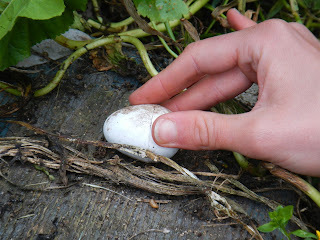From March through August,
Southeast Farallon is bustling with seabird activity, some more obvious than
others. The presence of the Western
Gulls is undeniable, and it is pretty hard to miss the 250,000 or so Common
Murres milling about as you approach the island. But some species here on the island, being more
reclusive and mysterious, don’t make their nesting presence as obvious. One
such species is the Cassin’s Auklet.
They nest primarily in burrows and rocky crevices underground and come
and go from the island only under the cover of darkness. Luckily for us, they can also be found nesting
in little wooden boxes with PVC pipe entrances and shaded roofs, which are
scattered around the island, tucked in among the Farallon weed, lavatera and
rocks.
 |
| Cassin’s Auklet in a nest box, photo courtesy of Annie Schmidt. |
PRBO researchers began building and
installing these artificial nest boxes in the early 70’s in order to provide
additional nesting habitat and to make it easier to monitor the nesting
phenology, breeding success, and chick growth rates of the auklets. Since then,
the use of artificial nest boxes to monitor the breeding biology of burrow
nesting seabirds has become a widely embraced technique. But, for those of us researchers who depend
on these nest boxes for our monitoring purposes; it is important for us to know
that the boxes are, indeed, providing an adequate environment for the birds
nesting within them. I am here on SEFI
to help PRBO and FNWR consider just that.
 |
| A Cassin’s Auklet nest box with shade cover. |
Environmental temperatures on the
Southeast Farallon Island were exceptionally warm during the 2008 and 2009
Cassin’s Auklet breeding seasons. These
anomalously warm temperatures meant that the artificial nest boxes turned into
little hotboxes, which was distressing to some of the auklets nesting within. In 2009, to help mediate this problem, PRBO
researchers created shade structures for all occupied nest boxes and started a
pilot study to better understand the differences in temperature experienced by
the auklets in artificial and natural burrows. Initial results showed that natural burrows
were significantly cooler than nest boxes but putting shades on nest boxes
decreased the nest box temperature notably.
Since 2009, all nest boxes with auklets nesting in them are covered in
shades.
The goal of my project is to take
this study one step further. I want to see
if the adult auklets in nest boxes are able to control egg temperature when
nest box temperatures are elevated, and how this may affect their hatching
success.
 |
| Reaching into an auklet home to switch out an egg. |
For my project, I put devices that recorded temperature in
hollow artificial Cassin’s Auklet eggs.
I then put the artificial egg in the auklets nest for a couple days to
record egg incubation temperature. The
goal of the project was to compare the incubation temperature of auklets in
different nest types- natural burrows, shaded nest boxes, and unshaded nest
boxes. Once I have chosen the nests
where my artificial eggs were to be deployed, I diligently babysat the auklets
real egg in a poultry incubator while the temperature loggers were deployed for
seven days.
 |
| Cassin’s Auklet eggs, safe and warm in the incubator. |
 |
An
artificial egg, ready to go inside a Cassin’s nest box.
|
 | |
| The artificial eggs and wire pulling lubricant. |
This project has also given me the amazing opportunity to spend the season participating in all the other seabird studies that are carried out on this SEFI. I have learned so much and made some wonderful memories out here.
I just arrived on SEFI for my second season deploying
Cassin’s Auklet eggs, in which I hope to increase my sample size and get a
better idea of the differences in incubation temperature between natural and
artificial nest habitats and how the auklets may mitigate for this. It is our hope that the results of this study
could lead to the design and implementation of new and improved nest boxes of
the Cassin’s Auklets on SEFI. In the
meantime, I am so happy to be back out here on this incredible island and I
look forward to whatever the season has in store!
Emma Kelsey
PRBO research assistant and graduate student at San Jose
State University